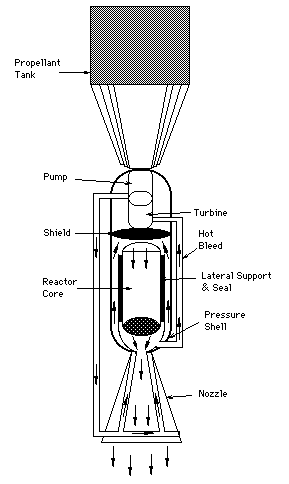An Inside View: How Do Nuclear Rockets Work?
Before learning about nuclear rockets, we should take a quick detour to review how conventional rockets work.
There is a perception that rockets are fiendishly complex devices that need to be serviced and designed by people whose intelligence is far removed from that of mere mortals. Often, people even use the term “rocket scientist” to describe someone of high intelligence and educational achievement. However, rockets are some of the simplest engines man has ever produced.
Fireworks to Titan IV
The Chinese figured out how to make them work thousands of years ago. The largest Titan IV rocket motor uses the same physical principles as ancient Chinese fireworks. Both obtain their acceleration by continuously emitting a stream of rapidly moving particles. Rocket motors consist of a heat source, a propellant supply and a nozzle. If the heat source uses a chemical combustion process, it must provide its own oxygen supply.
In a rocket that you can buy at a hobby shop, the power comes from a solid fuel with an integrated oxygen source, the gas is the product of burning that fuel, and the nozzle is formed by packing in the solid fuel. These rockets are simple, somewhat reliable and very inexpensive. The engines can lift a small balsa wood rocket to several hundred feet – if all goes well.
Chemical Rockets
Of course, things get a little more complicated if the rocket’s mission is to lift large weights and human beings out of the earth’s atmosphere. Efficiency, raw power and reliability become far more important and difficult to achieve.
Chemical rockets generally use either a solid rocket fuel like ammonium perchlorate (AP) or cryogenic liquid fuels like hydrogen and oxygen in separate tanks. Some systems, like the American space shuttle, use both kinds of rockets.
Limitations
Chemical rockets have their limits. Designers can only pack in a certain amount of energy, which is governed by the energy density of the available fuel. Normally, high performance rockets carry fuel and motors in several stages.
Doing this allows the weight of tanks and pumps to be dropped off after a certain amount of fuel has been expended. Staging was absolutely required to allow the Apollo program’s success. As it was, the weight useful for astronauts and scientific equipment was tiny compared to the weight of the fuel and engines.
The designers of chemical rocket motors are also limited in their selection of propellant gas. In rocket motor design, lightweight propellants are advantageous because they can be accelerated to much higher velocities.
A chemical rocket’s propellants are necessarily compounds formed by combustion. The lightest combustion product available is generally water, with a molecular weight of 18. Ideally, rocket designers would like to use a propellant gas like hydrogen or helium, with molecular weights of 2 or 4 respectively, instead of H2O.
The most powerful chemical rockets ever built were just slightly more than adequate to the task of taking men to the moon and back. A round trip to Mars, our neighbor planet, would require almost a year under the limits of chemical propulsion. The voyage would also require the construction of a space station in earth orbit and several launches to allow the assembly of all of the required equipment in space.
Nuclear Energy Steps In
Visionary engineers began talking about using nuclear heated rocket motors to overcome some of the limits of chemical rockets as soon as it became evident that man had figured out how to release the tremendous stored energy in atomic nuclei in a controlled fashion.
The incredible energy density represented by heavy metals offered rocket designers the opportunity to attack the twin limits of conventional rocket motors. Uranium is far more energy dense than hydrogen and oxygen, and the lightest elements in the universe can be used as propellants to improve the specific thrust.
The engineers who became advocates of nuclear rocket propulsion were sometimes derided by their peers as being “stargazers.” However, their decision to pursue nuclear rocket engines was based on a clear-headed, numerically-based approach to technology. Of course, they were partially motivated by being involved in the space race, a most invigorating technical challenge.
Calculations performed as part of the space nuclear propulsion program show that a first generation nuclear thermal rocket will allow a performance improvement of between 50 and 400 percent over the best conventional rocket motors. The specific impulse available will be approximately twice what a chemical rocket can produce.
Below is a simplified drawing of a nuclear rocket concept that was tested during the 1960s. At least a dozen such rocket motors were ground tested here on earth, most with excellent results.

The propellant, usually hydrogen, is stored as a liquid in the tank. The pump forces the propellant through the piping system the surrounds the nozzle and rocket motor. The propellant becomes heated and expands to a gas, at the same time limiting the temperature of the shell and nozzle.
The propellant enters the reactor to be heated and accelerates out the nozzle to provide thrust. Some of the heated fluid is used to turn the turbine driving the pump.
(Not shown, but very necessary in a working rocket are control nozzles to help steer to the rocket.)
